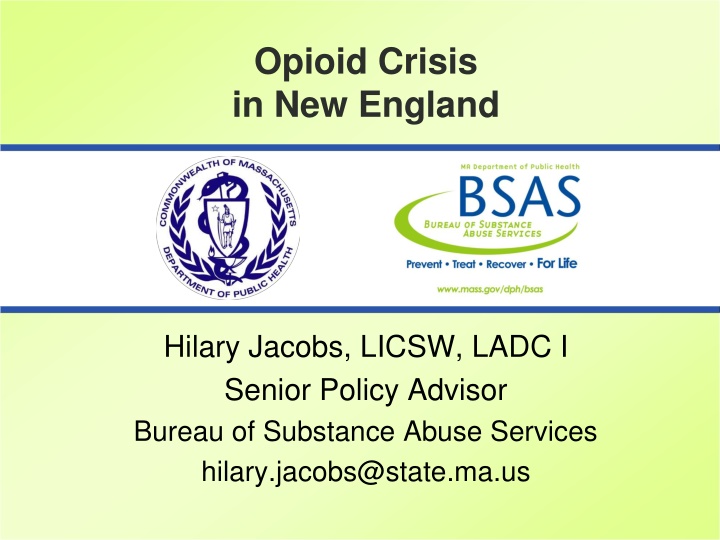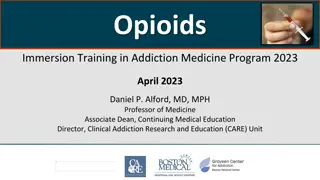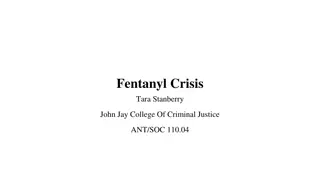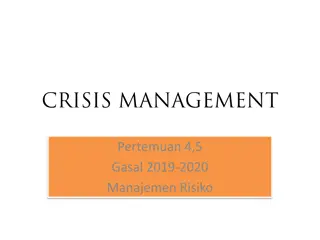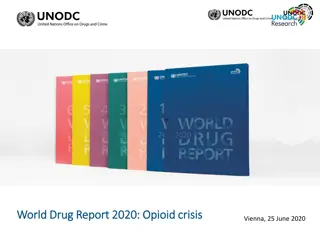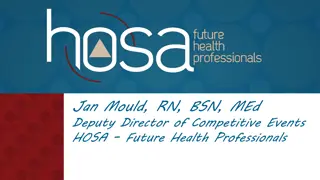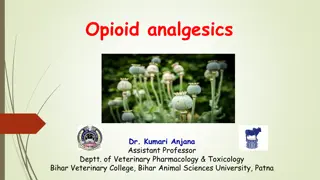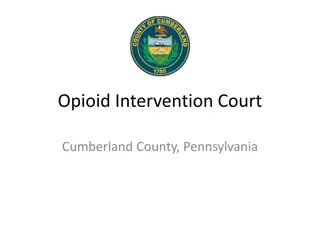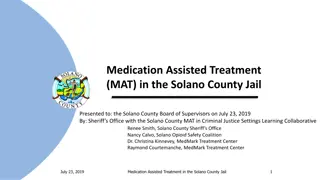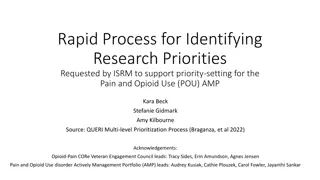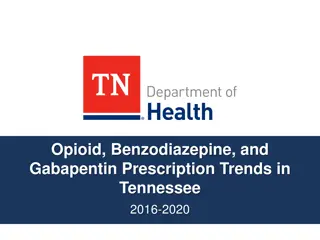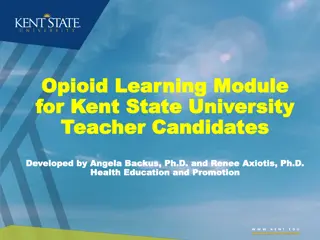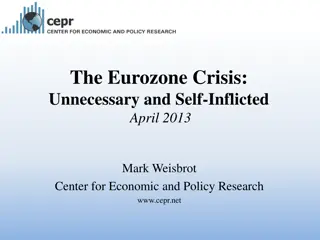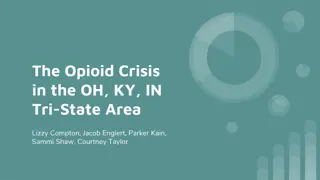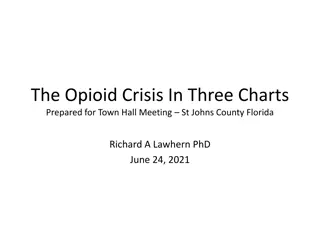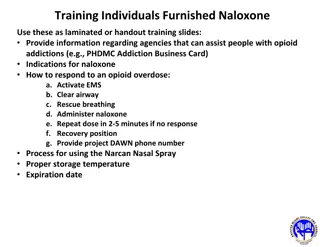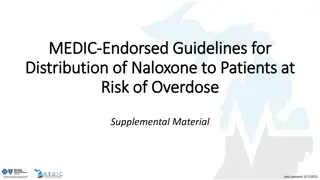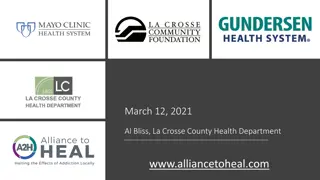Opioid Crisis in New England: Understanding the Scope and Impact
The presentation delves into the opioid crisis in New England, covering the nature, scope, and strategies to address the problem. It provides insights on the national picture, fatal and non-fatal overdoses, past year initiates for illicit drugs, and nonmedical pain reliever use. The data highlights the severity of the crisis with statistics on addiction, overdose deaths, and sources of obtaining pain relievers. The information presented sheds light on the ongoing challenges and the urgent need for effective interventions to combat this crisis.
Download Presentation

Please find below an Image/Link to download the presentation.
The content on the website is provided AS IS for your information and personal use only. It may not be sold, licensed, or shared on other websites without obtaining consent from the author.If you encounter any issues during the download, it is possible that the publisher has removed the file from their server.
You are allowed to download the files provided on this website for personal or commercial use, subject to the condition that they are used lawfully. All files are the property of their respective owners.
The content on the website is provided AS IS for your information and personal use only. It may not be sold, licensed, or shared on other websites without obtaining consent from the author.
E N D
Presentation Transcript
Opioid Crisis in New England Hilary Jacobs, LICSW, LADC I Senior Policy Advisor Bureau of Substance Abuse Services hilary.jacobs@state.ma.us
AGENDA Nature and Scope of the Opioid Problem National New England How We Got Here Strategies for Addressing the Problem National New England
National Picture 2012 2.1M SUD related to opioid pain relievers 467,000 addicted to heroin 14.4% of pregnant women were prescribed an opioid during pregnancy Unintentional opioid overdose death has quadrupled since 1999
Fatal and Non-fatal Overdoses 2014 Census Estimate* Fatal Year of Data CT 344 2014 3,596,677 MA 978*estimated 868 confirmed 2013 6,745,408 ME 1,330,089 NH 1,326,813 RI 208 2014 1,055,173 VT 626,562
Scope of the Problem 868 confirmed deaths, 978 estimated deaths Source: Office of Data Management and Outcomes Assessment February 2015
National Past Year Initiates for Specific Illicit Drugs among Persons Aged 12 or Older, 2012 Source: SAMHSA, National Survey on Drug Use and Health, 2012
Past Year Nonmedical Pain Reliever Use by Age Group in US & New England States, 2011-2012 Nonmedical use of prescription-type psychotherapeutics includes the nonmedical use of pain relievers, tranquilizers, stimulants, or sedatives and does not include over-the-counter drugs. Source: SAMHSA, National Survey on Drug Use and Health, 2011-2012
Where Pain Relievers Were Obtained for Most Recent Nonmedical Use among Past Year Users Aged 12 or Older, United States, 2011-2012 Source Where Respondent Obtained Bought on Internet 0.2% Drug Dealer/ Stranger 4.3% Other 1 5.0% Source Where Friend/Relative Obtained More than One Doctor 1.8% More than One Doctor 3.6% Free from Friend/Relative 5.4% Free from Friend/Relative 54.0% One Doctor 19.7% Bought/Took from Friend/Relative 5.4% One Doctor 82.2% Bought/Took from Friend/Relative 14.9% Drug Dealer/ Stranger 1.4% Other 1 1.8% Bought on Internet 0.2% Source: SAMHSA, Center for Behavioral Health Statistics and Quality, National Survey on Drug Use and Health, 2011-2012. Note: Totals may not sum to 100% because of rounding or because suppressed estimates are not shown. 1The Other category includes the sources: Wrote Fake Prescription, Stole from Doctor s Office/Clinic/Hospital/Pharmacy, and Some Other Way.
Relationship Between Prescription Medication and Heroin Use Nonmedical use of prescription drugs (NMPR)*: Drugs that were not prescribed for the person taking them OR; Drugs used only for the experience of feeling they caused *National survey on Drug Use and Health definition Access is a factor in misuse, abuse and addiction to all substances of abuse While most individuals who use pharmaceutical opioids do not transition to heroin use, some do When this happens the process often begins with NMPR use When pharmaceutical opioids are used non-medically the route of administration is sometimes altered (snorting or injecting) 4 out of 5 recent heroin initiates used pain relievers non-medically preceding first heroin use** Previous heroin use has not been shown to relate to onset of NMPR use** Substance Abuse and Mental Health Services Administration Center for Behavioral Health Statistics and Quality August 2013 Associations of Nonmedical Pain Reliever Use and Initiation of Heroin Use in the United States , Pradip K. Muhuri, Joseph C. Gfroerer, M. Christine Davies
Prescription opioid sales, deaths and treatment: 1999-2010 National Vital Statistics System, 1999-2008; Automation of Reports and Consolidated Orders System (ARCOS) of the Drug Enforcement Administration (DEA), 1999-2010; Treatment Episode Data Set, 1999-2009
Other Factors 1995 Pain as the fifth vital sign Idea endorsed by the VA and the Joint Commission 2006 CMS adopted a standardized quality measure that rates hospitals/doctors on patient satisfaction with pain management Hospital Consumer Assessment of Healthcare Providers Report Report measures 8 domains (dimensions) Pain management one dimension Scores are related to incentive payments hospitals receive 2011 IOM publishes Relieving Pain in America
Other Factors US is one of two countries that allows direct to consumer pharmaceutical advertising1 US consumes 80% of world s narcotic prescription medications2 99% of the world s hydrocodone (Vicodin)2 Heroin is cheap, pure and sometimes adulterated 1http://www.fda.gov/downloads/ForConsumers/ConsumerUpdates/UCM107180.pdf 2Manchikanti, L. Fellows, B. Ailinani, H. and Pampati, V. Therapeutic Use, Abuse, and Nonmedical Use of Opioids: A Ten-Year Perspective. Pain Physician, Sep 2010.
Opioid Overdose Prevention Policies The Trust for America s Health Prescription Drug Abuse: Strategies to Stop the Epidemic 2013 provides a snapshot of the range of evidence- informed policies in place in different states. Zero is the lowest possible overall score (no policies in place), and 10 is the highest (all the policies in place)
INDICATORS 1. Prescription Drug Monitoring Program: Does the state have an operational Prescription Drug Monitoring Program? 2. Mandatory Use of PDMP: Does the state require mandatory use of PDMPs by providers? (any form of mandatory use requirement) 3. Doctor Shopping Law: Does the state have a doctor shopping statute? 4. Support for Substance Abuse Services: Has the state expanded Medicaid under the Affordable Care Act, thereby expanding coverage of substance abuse treatment? 5. Prescriber Education Requirement: Does the state require or recommend education for prescribers of pain medications? 6. Good Samaritan Law: Does the state have a law in place to provide a degree of immunity from criminal chargers or mitigation of sentencing for an individual seeking help for themselves or others experiencing an overdose? 7. Support for Naloxone Use: Does the state have a law in place to expand access to, and use of, naloxone for overdosing individuals given by lay administrators? 8. Physical Exam Requirements: Does the state require a healthcare provider to either conduct a physical exam of the patient, a screening for signs of substance abuse or have a bona fide patient-physician relationship that includes a physician examination, prior to prescribing prescription medications? 9. ID Requirement: Does the state have a law requiring or permitting a pharmacist to ask for identification prior to dispensing a controlled substance? 10. Pharmacy Lock-In Program: Does the state s Medicaid plan have a pharmacy lock-in program that requires individuals suspected of misusing controlled substances to use a single prescriber and Pharmacy?
State Scores 10 9 8 7 6 (2 states) (4 states) (11 states) (5 states) (11 states & D.C) New Mexico Vermont Kentucky Massachusetts New York Washington California Colorado Connecticut Delaware Illinois Minnesota North Carolina Oklahoma Oregon Rhode Island West Virginia Florida Nevada New Jersey Tennessee Virginia Arkansas D.C. Georgia Hawaii Iowa Louisiana Maryland Michigan North Dakota Ohio Texas Utah 5 4 3 2 (8 states) (6 states) (2 states) (1 state) Alaska Idaho Indiana Maine Mississippi Montana New Hampshire South Carolina Alabama Arizona Kansas Pennsylvania Wisconsin Wyoming Missouri Nebraska South Dakota
CT MA ME NH RI VT First Responder Naloxone State Police mandate; other first responders voluntary Yes Yes Yes Yes Yes Bystander Naloxone Yes Yes Yes In progress Yes Yes ED Intervention for non-fatal overdose No No No No Yes No Medicaid payment for all 3 MAT Yes/No Limit Yes/No Limit Yes/Limit Buprenorphine & Methadone. 2yr limit for both Yes/No limit Yes/No limit Yes Peer Recovery Coaches Yes, telephone Yes Yes Yes Yes Yes Recovery Support Centers Yes Yes Yes Yes Yes Yes Recovery High Schools No Yes No No Yes No Interstate PMP Data Sharing Yes Yes No In process Not Yet In process Safe Opioid Prescribing Regulations ED Guidelines only No Yes Yes Yes Guidelines only Naloxone Pharmacy Access/standing order Leg pending allowing pharmacists to prescribe over the counter Yes No No Yes In process
Other Innovations Regional Approach Safe Opioid Prescribing; Prevention Messaging; Law Enforcement; Cross Border Tx Access; Interstate PMP Data Sharing Set limits on MME Require commercial payment for MAT under parity MA specific: Pairing treatment providers with first responders PMP Alerts Linking data on suspected opioid overdose victims with PMP and SUD treatment data Working with licensed providers about what they can do
MA Touchstones Robust response requires a public health and public safety approach Beginning to explore replicating the NJ Drug Monitoring Initiative model Communicating everyone has a role in responding Idea of Touchstones
REMEMBER TREAT ADDICTION SAVE LIVES
